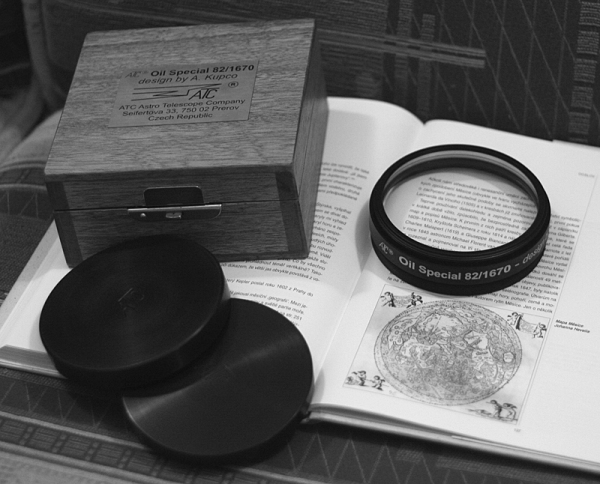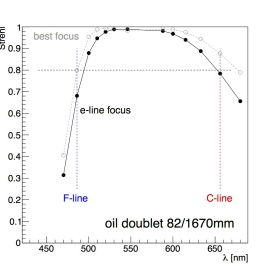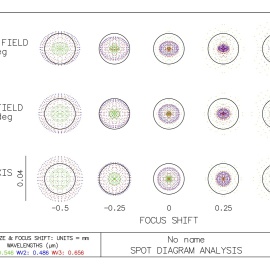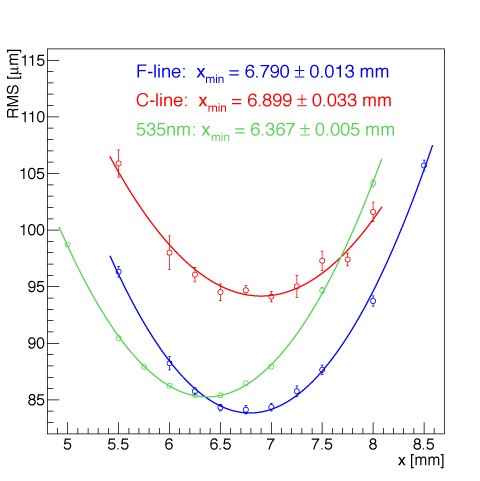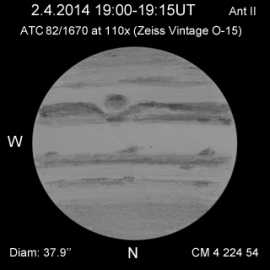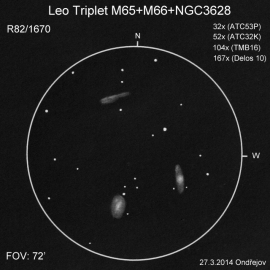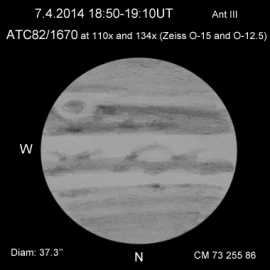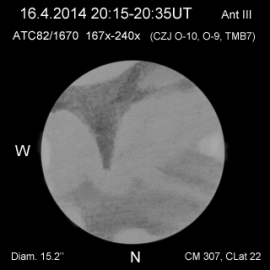ATC82 - Oil special doublet F20
dicembre 2014 - un progetto vecchio rivitalizzato
di Alexander Kupˇco
INTRODUZIONE
C’è una certa mitizzazione di alcuni prodotti del secolo scorso che meritano giustamente grande considerazione ma che il mercato collezionistico ha eccessivamente rivalutato. Esempio emblematico è quello della serie “AS” di Zeiss, doppietti in configurazione Steinheil che permettono ottime prestazioni in alta risoluzione ma che, per quanto ben corretti e ottimizzati nelle lunghezze del rosso, non sono alla pari di quanto offerto dai più moderni apocromatici di alto livello, almeno nella complessità dello spettro ottico. Un amatore, con l’aiuto di una piccola azienda ottica, ha rivitalizzato il progetto originario degli AS e, a quanto risulta dai report dell’autore, reso ulteriormente performante.
E’ il capostipite di una possibile nuova linea di strumenti di nicchia? Non lo sappiamo ma l’esperimento merita attenzione.
Ho deciso quindi di riportare per esteso e in versione originale la storia e il primo test di questo piccolo doppietto in olio da 82 millimetri di apertura e 1670 mm. di focale.
OBIETTIVO, CONSIDERAZIONI, TEST E SKETCHES
I got mad and I have designed my own lens. Not only that, I actually got it executed by a skilled optician. This short article is about my motivation and the first views through the result of this effort.
Bad weather in winter 2012 should be ac- cused of it. There was no decent observing night for more than four months. Just here and there, short peaks on Jupiter and Mars through clouds or strong haze veil. I had nothing better to do than just study several optical designs for refractors.
In last two years, I was falling more and more in love with small refractors. Especially with Zeiss AS80/1200. By now, I own two lenses of this type. One from the Eastern Germany times, this is my work-hoarse, the second nice in brass piece from the WW-II times.
I was eagerly reading all I could find about the design of old refractors. In particular I liked oil triplets, especially the ingenious de- sign from Wolfgang Busch. Based on short flint, the same as in the Zeiss AS lenses, it offered for 130mm and 150mm f/15 lenses semi-apo performance. The design was well thought of with the emphasis on simplicity
and possibility to make it by skillful amateur.
Unfortunately, the short flint KzF2 is not readily available anymore. I decided to scan current glass catalogues from Ohara and Schott to see if the idea of short flint based refractors could be resurrected in the era of low dispersion ED glasses. The an- swer could be guessed, as the companies, like Astro-Physics, switched from their early types apochromats based on short-flints to ED glasses long time ago.
Nevertheless, I had a lot of fun with the project and I have learnt a lot about optics and its design and final execution. This is af- ter all the main reason why I was proceeding with the project. Economically, there was no point of trying it. You can’t beat the cheep ED-based refractors coming from China.
I solved analytically the Busch’s oil triplet, even its modification with curved last surface to completely suppress the coma. This re- quired some algebraic skills to reduce quar- tic equation down to quadratic as in the case of Fraunhofer doublet. Later on, when I got the numbers of Zeiss APQ lens radii, I was pleased that my solution (for thin lenses and paraxial focus) was very close to those. I
went even further and I have solved general oil triplet with three different glasses for the special case of nearly apochromatic perfor- mance. All this allowed me to quickly evalu- ate ten thousands of glass pairs, millions for general triplet, without using heavy design programs like OLSO.
In particular, I liked the combination of Ohara short flint S-NBM51 (an equivalent of Schott N-KZFS5) with Schott N-SK2. Based on the price factors in the catalogues, this combination should be cheaper than doublets based on the cheapest S-FPL51 ED glass. It is also providing colour correction slightly su- perior to Zeiss AS lenses1.
In addition, those two glasses exhibit the same index of refraction and also the same thermal properties. Same refractive index is a handy feature. If your immersion matches their refractive index then it is like there is no optical surface at all. In case of Busch triplet, there was even no need to polish the internal surfaces. This was not the case at the end for my doublet as I could not easily find an oil with refractive index of about 1.61. Cinna- mon oil would work with additional benefit of nice smell, but I was afraiding of the bio- logical oil degradation. I have opted for the silicon based oil, with refractive index of 1.52 it was close enough introducing less than per- mill light loss.
Same, and low, coefficients of the ther- mal expansion are another nice feature of the glass combination. The two discs shrink and expand in the same way. It should improve the thermal properties of the lens, probably, although I’m not sure of it.
At the end, I was not able to buy single disc of N-SK2 from Schott. Luckily, Ohara has its equivalent S-BSM9 with almost the same properties. Just less chemically stable and with even slightly better colour correction factor (∆f/f ∼ 1/3400). Opting for Stein- heil configuration with leading short flint, S-NBM51 is chemically very stable, solved the problem.
With all this, one could make out of the pair S-NBM51+N-SK2/S-BSM9 nice mod- ern equivalents of Zeiss AS lenses. For the air-spaced doublet with reasonably thin lenses, the objective could be made at speeds up to about f/14 (slightly faster with N-SK2),
oil triplets could be made f/11.
I wanted to start with something smaller in about 80mm size, not shoot directly for a large triplet. An AS80/1200 equivalent could have been designed and built easily. But I did not want a third 80mm f/15 lens. Instead of this, I decided to go for f/20.
There were few interesting aspects con- nected with such a slow optics. The colour factor SN2 used by Zeiss to characterise the level of colour correction of their lenses should be SN2 = 1.1, i.e. very close to the level Zeiss considered to be apochromatic. The lens would than just resemble very first Zeiss apochromatic doublets based on short flints.
The f/20 doublet does not need the addi- tional degrees of freedom the air-spaced lens offers with respect to the oil doublets. The spherical aberration and coma are very small and the oil doublet could have been even made with its last surface flat. There would be only one surface, the front one, to tune. I liked this simplicity.
The last argument for f/20 was practical. I could put the lens, with a proper interface, into the tube that I’m using for Zeiss AS110 lens. No need to build new OTA and I could start using the lens immediately. I can al- ways build a dedicated and slightly lighter tube later on in case of success.
1Relative colour defocus in C and F Fraunhofer lines with respect to the e-line is ∆f/f ∼ 1/3200 versus 1/2800 for AS.
The overall performance of the lens can be judged from the strehl diagram displayed on the previous page. At the best polystrehl focus, the lens exhibits perfect performance (strehl better than 0.95) in wide range of wavelengths, from 500-630 nm. Good perfor- mance, strehl above 0.80, is achieved in the full range from Fraunhofer blue F-line up to red C-line.
The lens would work well only for visual observation, as the defocus for deep violet light (g-line at 435 nm) reaches 2.5 mm which introduces geometrical blur of 0.12mm, i.e. 15′′. This was noticed even visually as very faint, almost invisible deep violet halo around Jupiter.
After all these studies I pulled the trig- ger and ordered the glass. As Schott did not want to sell me just a single piece of N-SK2, I have opted for S-BSM9 equivalent from Ohara. Here came the first surprise, the S-BSM9 glass was supposed to be about three times cheaper than S-NBM51 according to the Ohara’s catalogue. In fact, it cost the same and I had to wait for it for quite some time. I have orderder discs with diameter of 85 mm and thickness of 10 mm with very good annealing and homogeneous properties as I did not wanted to take with just one piece of the glass the risk of getting bad glass that would degrade the performance of the lens. After grinding, the total width of the glass was 16 mm.
At this step, it was clear that the econ- omy of the lens was making no sense with all this good quality ED doublets readily avail- able from China. Just the price of the two discs was somewhere in between the full price of Skywatcher ED80 and ED100 telescopes.
I asked optician Jarom ́ır Holubec, the owner of small optical workshop ATC Tele- scopes in Prerov, to execute the lens. I have zero experience with grinding the glass, I would like to learn this skill at some point but realistically, this was not the right time to do it. The glass was too expensive. I also decided not to coat the outer surfaces in order to preserve as much of smoothness as possi- ble.
I was very happy when Mr. Holubec ac- cepted. Based on the experience with his eyepieces, for example nice M44x1 threaded 40mm Kellner or 53mm Plossl, I knew he was going to do the perfect job and he would build the lens as best as he can.
Although I passed all the hard work of making the lens to the optician, there was still some optical work left for me. Due to the simplistic design, there are not many ways how to fine tune the performance of the lens. Internal radii are fixed and the last surface is flat. That leaves just the first surface.
Given the precision of the dispersions of the glasses provided by the glass factory, the sur- face radii could not be computed with enough precision. The foci in blue and red light could differ up to 0.36 mm. Not much compared to 1 mm defocus of traditional achromat but rel- evant for apochromatic performance as the overall defocus in those two lines should be 0.5 mm. It is in the nature of the lens design, that the red and blue foci could be tuned and brought together by small, about 1% changes of radii of the first surface.
I set up an experiment to measure this dif- ference in red and blue lines. I used double pass configuration and put in front of the lens a mask with narrow arcs at 70% of the lens radius. For red, I used my Hα filter, and for blue Hβ filter. I was of course also curios about the colour defocus with respect to the green light to judge the colour performance of the lens. For that, I used Astronomik True Type IIc G filter from the LRGB set. It cen- ters around 530nm which is slightly lower value than e-line, but the difference in their foci should be only about 0.02 mm.
Combining several independent measure- ment, like the one displayed on the previous page, showed that the focus in blue line is closer to the green one than the red light by about 0.10 ± 0.02 mm. This is basically ideal situation as my 1.25” Baader/Zeiss zenith prism introduces exactly the same shift but in the opposite direction making the system with identical foci in C and F lines. At the end, there was no need to touch the lens any- more.
The overall defocus ∆f in C and F lines with respect to my green filter was measured to be 478 ± 18 μm. Using catalogue numbers for a small correction between 535 nm (value for the G filter) and e-line, this would bring final colour defocus with respect to the green line of
∆f = 498 ± 18 μm , in good agreement with the catalogue num- ber 522 μm. The corresponding colour factor is than indeed very close to one SN2 = 1.11 ± 0.04 .
By now, you can imagine my excitement when, after two years since I had begin to think about new lens, I pointed the result of this effort towards the night sky finally. The first light night turned out to be a good one and I went to my darker-side observatory where I kept the AS110. I was going to use its tube to mount the lens. The atmospheric transparency could had been better but the seeing was excellent which allowed for a strict test of the lens.
The first target had to be Jupiter. It was still well positioned for a good test. After the first peek through TMB16 (104×) I knew the lens was really excellent. That was a great relieve, it was still quite possible that I had made some error in the calculations or there could had been some misunderstanding be- tween me and the Jarom ́ır Holubec from ATC as we have never met actually. All the worries were forgotten. I was also happy to notice no signs of thermal effects although the temper- ature was quite low.
I was cranking the power even more to 134× and 167× and the view was still quite crisp without any hints of colour aberration, except very faint, deep violet halo around Jupiter. More important than the faint halo was the presentation of Jupiter surface. The texture, richness and smoothness of the view seemed to me even better of what I was used to see through AS80/1200. In fact, the qual- ity of view was more alike the view in AS110 which I judge to be optically slightly superior to AS80.
In the place of NTB, there were two thin belts, each showing interesting irregularities, There was also another darkening on the easter edge in STB visible in moments of good seeing as a thin very dark strip. There were also several festoons peeping out of NEB towards the equatorial region. See in the pre- vious page the rough sketch made directly at the eyepiece.
Next target for sketching was spectacu- lar Leo triplet made of galaxies M65 (V9.3, 9.8′ × 2.9′, PA165◦), M66 (V9.0, 9.1′ × 4.2′, PA173◦), and NGC 3628 (V9.8, 14.8′3.0′, PA104◦ ).
M65 was looking at low magnification of 32× as a quite elongated oval with central stellar brightening. Its southern end looked brighter but larger magnification of 104× showed that it was just a faint star. The nucleus was not stellar any more at 104×, it was small rounded bright spot. Northern edge was showing faint elongated brightening at its tip. Two stars could be seen near the southern edge.
Galaxy M66 was at 32× the most obvious of the trio. Thanks to nearby four stars, this region looked a little bit like a small open cluster with hazy background. The galaxy had bright stellar nucleus while the body was elongated in the north-south direction. The galaxy looked slightly more bulky in its southern end.
Higher magnifications of 104× and 167× were showing still stellar nucleus. There were several brightenings in the central re- gion but I could not see anything more defi- nite than just hints of the central bar running in NWN-SES direction (pointing to a nearby bright star NWN from the galaxy). The other brightening that I localised was slightly north from the nucleus. I’m not sure it was real as no images show any significant object in there. However, Gabor Santa sketched this feature in 10cm reflector as is presented in lovely book Star atlas for small telescopes by Peter Vizer.
I was also looking for the southern, more opened arm which I saw previously from the same location in AS110. But I couldn’t see any hint of it, there was just faint star west of the souther end, according to CdC its visual brightness is V=13.4. Noticing such a faint star was another good sign. With ED100, I was able to see stars below 14.0 magnitude, this threshold would translate to 13.3 for the 82mm uncoated doublet.
Galaxy NGC 3628 was at 32× and 52× strongly elongated and pretty faint. Al- though, after some time spent at the eyepiece, it became quite distinct. My estimate of its length was 8′. The western part was slightly fainter and narrower, the middle and the eastern part was more thick. The northern edge was more sharp. Large magnification of 167× was showing two elongated bright- enings revealing the presence of the central dark line.
Then I performed star test to evaluate the optics more systematically. For that purpose, I was using bright star Regulus. I was look- ing through zenith prism with no filter em- ployed. In inside focus with 4-5 inner rings, the main body of pattern was slightly yel- lowish while the edge was showing very light violet colouring. In the outside focus, the colours switched: the center was slightly vio- let while the edge was slightly yellow.
Concerning the spherical aberration, the inner rings were equally well visible in inside and outside focus and not much of concen- tration was required to see them. The outer ring was thicker as it should, I also did not notice any change between the brightness of the inner rings and the outer ring. To con- clude, I was not able to detect any signs of spherical aberration and I would say it is at least at λ/8 or better. You shouldn’t take those numbers too seriously, I’m not too ex- prienced star tester. When I repeated the test three months later, I was able to detect small changes in the inside and outside pattern but very probably below λ/8.
The only visible aberration I was able to detect was slight astigmatism. This could be simply due to a lack of collimation or due too tight ring holding the lens. In one cold night, the asterism was severe, releasing the hold ring a little bit restored back quickly the good lens performance. I repeated the test without zenith prism with the same results, if anything, the asterism seemed a little bit less pronounced.
The next target was double ξ UMa (4.3+4.9, 1.7′′, 245◦). At 167×, I saw beau- tiful pair of two nice almost touching spheres nicely boarded by the first diffractive ring. I estimated the difference in brightness to be of ∆m ∼ 0.4.
I have quickly looked at two more galaxies in this area NGC 2841 (V9.5, 8.1′ × 3.5′, PA147◦) and NGC 2681 (V10.1, 3.6′ × 3.3′) and then I jump directly to Mars. It was showing unfortunately its “boring” side but even there I was able to feel, besides obvious northern polar cap, a presence of few albedo features: equatorial clouds near the western edge and some darkening.
During the spring and early summer, I made numerous observations of planets, two best sketches of Jupiter and Mars are dis-played here. I was pleased to observe the lens did not show even the slightest signs of ther- mal effects. This was one of the goal of the design – an ultimate lens that could be used for short winter planet and Moon sessions.
In the direct comparison with AS80/1200 my earlier suspicion about better oil dublet optics was confirmed. This was another un- spoken goal of this exercise. The oil doublet was showing the small features, like the Great Red Spot, with more authority. The view was slightly more calm while (probably) some thermal effects could be still traced in AS80.
I have find out that the tube without dew shield was at the limit of usability with my alt-az mount Skywatcher AZ5. Therefor I was able to use the lens quite effectively from my backyard with my current setup. This was good sign, it seems that with properly designed light tube I would be able to use the mount for quick sessions.
So far so good. I’m not sure I would build another lens but I’m glad I went through the whole process, from the design to the ac- tual realisation. If for nothing than just for my own education. Now, there is one more bonus. Observing with own optics adds a new dimension to the enjoyment of the night sky. I’m sure there are many wonderful nights in front of us. In particular, I’m looking forward for the upcoming winter Jupiter season. This would be a real field test in which, I hope, the strength of the lens would show up
PRIME CONCLUSIONI
Quanto riportato è la trascrizione fedele dell’articolo di Alexander Kupˇco, autore del progetto ottico e padre putativo del doppietto esaminato. Prendo per vere le sue affermazioni (che mi sembrano anche verosimili in linea generale) e, benché i suoi “schizzi” denotino un po’ di inesperienza il suo progetto sembra molto valido. Non so se questa ottica avrà un seguito ma, a scanso di equivoci, ho scritto alla ATC Astro Telescope Company per chiedere informazioni a riguardo.
Vediamo "cosa" e "se" mi rispondono...
